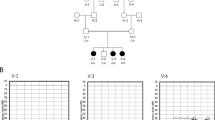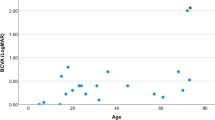Abstract
Objectives
We studied 45 patients with Wolfram syndrome 1 (WS1) to describe their clinical history and to search for possible genotype–phenotype correlations.
Methods
Clinical criteria contributing to WS1 diagnosis were analyzed. The patients were classified into three genotypic classes according to type of detected mutations.
Results
WS1 prevalence in Italy is 0.74/1,000,000. All four manifestations of DIDMOAD were found in 46.7% of patients. Differently combined WS1 clinical features were detected in 53.3% of patients. We found 35 WFS1 different mutations and a novel missense mutation, c.1523A>G. WS1 patients were homozygotes or compound heterozygotes for WFS1 mutations except for 2 heterozygote patients (4.5%). Each genotypic group exhibited a different age onset of DM, D, and DI but not of OA. Genotypic Group 2 patients manifested a lower number of clinical manifestations compared to Groups 1 and 3. Moreover, genotypic Group 1 patients tended to have a shorter survival time than the other groups. No differences were found regarding type of clinical pictures.
Conclusions
Our study suggested that molecular WFS1 typing is a useful tool for early assessment of clinical history, follow-up, and prognosis of WS1.
Similar content being viewed by others
Log in or create a free account to read this content
Gain free access to this article, as well as selected content from this journal and more on nature.com
or
References
Page, M. M., Asmal, A. C. & Edwards, C. R. Recessive inheritance of diabetes: the syndrome of diabetes insipidus, diabetes mellitus, optic atrophy and deafness. Q. J. Med. 45, 505–520 (1976).
Barrett, T. G., Bundey, S. E. & Macleod, A. F. Neurodegeneration and diabetes: UK nationwide study of Wolfram (DIDMOAD) syndrome. Lancet 346, 1458–1463 (1995).
Lombardo, F. et al. Phenotypical and genotypical expression of Wolfram syndrome in 12 patients from a Sicilian district where this syndrome might not be so infrequent as generally expected. J. Endocrinol. Invest. 37, 195–202 (2014).
Wolfram, D. J. & Wagener, H. P. Diabetes mellitus and simple optic atrophy among siblings: report of four cases. Mayo Clin. Proc. 13, 715–718 (1938).
Rigoli, L. et al. Genetic and clinical aspects of Wolfram syndrome 1, a severe neurodegenerative disease. Pediatr. Res. 83, 921–929 (2018).
Urano, F. Wolfram syndrome: diagnosis, management, and treatment. Curr. Diab. Rep. 16, 6 (2016).
de Heredia, M. L., Clèries, R. & Nunes, V. Genotypic classification of patients with Wolfram syndrome: insights into the natural history of the disease and correlation with phenotype. Genet. Med. 15, 497–506 (2013).
Cano, A. et al. Microvascular diabetes complications in Wolfram syndrome (diabetes insipidus, diabetes mellitus, optic atrophy, and deafness [DIDMOAD]): an age- and duration-matched comparison with common type 1 diabetes. Diabetes Care 30, 2327–2330 (2007).
Homa, K. et al. False diagnosis of type 1 diabetes mellitus and its complications in Wolfram Syndrome is it the reason for the low number of cases of this abnormality?. Endokrynol. Pol. 65, 398–400 (2014).
Yamamoto, H. et al. Wolfram syndrome 1 (WFS1) protein expression in retinal ganglion cells and optic nerve glia of the cynomolgus monkey. Exp. Eye Res. 83, 1303–1306 (2006).
Pickett, K. A. et al. Early presentation of gait impairment in Wolfram syndrome. Orphanet J. Rare Dis. 7, 92 (2012).
Rigoli, L., Lombardo, F. & Di Bella, C. Wolfram syndrome and WFS1 gene. Clin. Genet. 79, 103–117 (2011).
Inoue, H. et al. A gene encoding a transmembrane protein is mutated in patients with diabetes mellitus and optic atrophy (Wolfram syndrome). Nat. Genet. 20, 143–148 (1998).
Strom, T. M. et al. Diabetes insipidus, diabetes mellitus, optic atrophy and deafness (DIDMOAD) caused by mutations in a novel gene (wolframin) coding for a predicted transmembrane protein. Hum. Mol. Genet. 7, 2021–2028 (1998).
Rigoli, L. & Di Bella, C. Wolfram syndrome 1 and Wolfram syndrome 2. Curr. Opin. Pediatr. 24, 512–517 (2012).
Fonseca, S. G. et al. WFS1 is a novel component of the unfolded protein response and maintains homeostasis of the endoplasmic reticulum in pancreatic beta-cells. J. Biol. Chem. 280, 39609–39615 (2005).
El-Shanti, H. et al. Homozygosity mapping identifies an additional locus for Wolfram syndrome on chromosome 4q. Am. J. Hum. Genet. 66, 1229–1236 (2000).
al-Sheyyab, M. et al. Bleeding tendency in Wolfram syndrome: a newly identified feature with phenotype genotype correlation. Eur. J. Pediatr. 160, 243–246 (2001).
Amr, S. et al. A homozygous mutation in a novel zinc-finger protein, ERIS, is responsible for Wolfram syndrome 2. Am. J. Hum. Genet. 81, 673–683 (2007).
Mozzillo, E. et al. A novel CISD2 intragenic deletion, optic neuropathy and platelet aggregation defect in Wolfram syndrome type 2. BMC Med. Genet. 15, 88 (2014).
Colosimo, A. et al. Molecular detection of novel WFS1 mutations in patients with Wolfram syndrome by a DHPLC-based assay. Hum. Mutat. 21, 622–629 (2003).
Gasparin, M. R. et al. Identification of novel mutations of the WFS1 gene in Brazilian patients with Wolfram syndrome. Eur. J. Endocrinol. 160, 309–316 (2009).
Hardy, C. et al. Clinical and molecular genetic analysis of 19 Wolfram syndrome kindreds demonstrating a wide spectrum of mutations in WFS1. Am. J. Hum. Genet 65, 1279–1290 (1999).
Aloi, C. et al. Wolfram syndrome: new mutations, different phenotype. PLoS ONE 7, e29150 (2012).
Kadayifci, A., Kepekci, Y., Coskun, Y. & Huang, Y. Wolfram syndrome in a family with variable expression. Acta Medica (Hradec Kralove). 44, 115–118 (2001).
Zalloua, P. A. et al. WFS1 mutations are frequent monogenic causes of juvenile-onset diabetes mellitus in Lebanon. Hum. Mol. Genet. 17, 4012–4021 (2008).
Tessa, A. et al. Identification of novel WFS1 mutations in Italian children with Wolfram syndrome. Hum. Mutat. 17, 348–349 (2001).
Gómez-Zaera, M. et al. Presence of a major WFS1 mutation in Spanish Wolfram syndrome pedigrees. Mol. Genet. Metab. 72, 72–81 (2001).
Piccinno, E. et al. Novel homozygous mutation in exon 5 of WFS1 gene in an Apulian family with mild phenotypic expression of Wolfram syndrome. Clin. Genet. 86, 197–198 (2014).
Pizzolanti, G. et al. Identification of novel WFS1 mutations in a Sicilian child with Wolfram syndrome. Genet. Syndr. Gene Ther. 5, 5 (2014).
Smith, C. J. et al. Phenotype-genotype correlations in a series of Wolfram syndrome families. Diabetes Care 27, 2003–2009 (2004).
Rigoli, L. et al. Identification of one novel causative mutation in exon 4 of WFS1 gene in two Italian siblings with classical DIDMOAD syndrome phenotype. Gene 526, 487–489 (2013).
Furlong, R. A. et al. A rare coding variant within the wolframin gene in bipolar and unipolar affective disorder cases. Neurosci. Lett. 277, 123–126 (1999).
Khanim, F. et al. WFS1/wolframin mutations, Wolfram syndrome, and associated diseases. Hum. Mutat. 17, 357–367 (2001).
Giuliano, F. et al. Wolfram syndrome in French population: characterization of novel mutations and polymorphisms in the WFS1 gene. Hum. Mutat. 25, 99–100 (2005).
Domènech, E., Gómez-Zaera, M. & Nunes, V. Study of the WFS1 gene and mitochondrial DNA in Spanish Wolfram syndrome families. Clin. Genet. 65, 463–469 (2004).
Ganie, M. A. et al. Presentation and clinical course of Wolfram (DIDMOAD) syndrome from North India. Diabet. Med. 28, 1337–1342 (2011).
Matsunaga, K. et al. Wolfram syndrome in the Japanese population; molecular analysis of WFS1 gene and characterization of clinical features. PLoS ONE 9, e106906 (2014).
Medlej, R. et al. Diabetes mellitus and optic atrophy: a study of Wolfram syndrome in the Lebanese population. J. Clin. Endocrinol. Metab. 89, 1656–1661 (2004).
Delprat, B., Maurice, T. & Delettre, C. Wolfram syndrome: MAMs’ connection? Cell Death Dis. 9, 364–376 (2018).
Author information
Authors and Affiliations
Contributions
L.R., G.D. and F.L. gave substantial contributions to conception and design of the study. C.A., A.S., C.D.B., G.S., R.C., E.M. and G.P. gave their contribution to acquisition of data or analysis and interpretation of data; L.R., R.C., G.D., F.L. and G.P. drafted the article and revised it critically for important intellectual content; L.R., G.D. and F.L. gave the final approval of the version to be published.
Corresponding author
Ethics declarations
Competing interests
The authors declare no competing interests.
Ethics
The research was conducted according to the Declaration of Helsinki and approved by IRCCS Giannina Gaslini Institute and University of Messina Ethical Committees.
Additional information
Publisher’s note: Springer Nature remains neutral with regard to jurisdictional claims in published maps and institutional affiliations.
Rights and permissions
About this article
Cite this article
Rigoli, L., Aloi, C., Salina, A. et al. Wolfram syndrome 1 in the Italian population: genotype–phenotype correlations. Pediatr Res 87, 456–462 (2020). https://doi.org/10.1038/s41390-019-0487-4
Received:
Revised:
Accepted:
Published:
Issue date:
DOI: https://doi.org/10.1038/s41390-019-0487-4
This article is cited by
-
Evaluation of pathogenic variant in WFS1 in a patient with Wolfram syndrome
Egyptian Journal of Medical Human Genetics (2025)
-
Clinical and Genetic Characteristics of Patients with Early-Onset Diabetes Involving at Least Two Consecutive Generations: Whole-Exome Sequencing in Probands from 25 Pedigrees
Current Medical Science (2025)
-
SID/SIEDP expert consensus on optimizing clinical strategies for early detection and management of wolfram syndrome
Journal of Endocrinological Investigation (2024)
-
Collaboration for rare diabetes: understanding new treatment options for Wolfram syndrome
Endocrine (2021)



